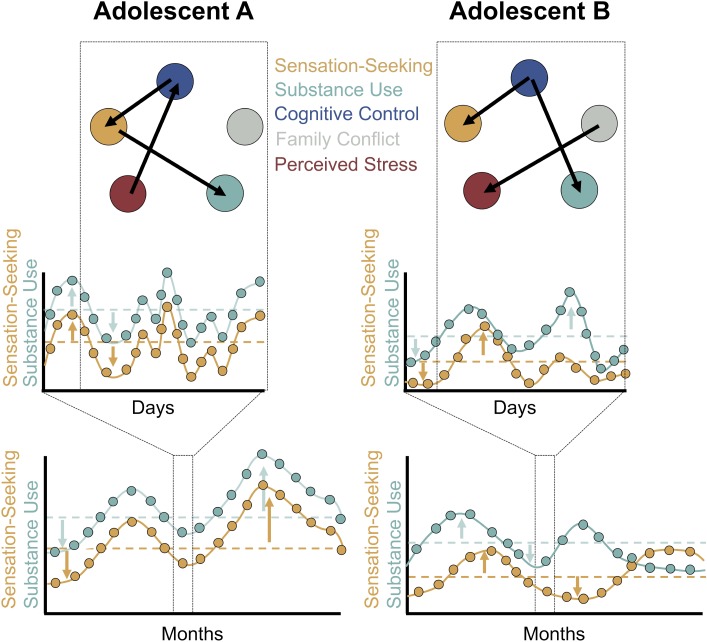FIGURE 2.
A sampling of the multiple timescales of sensation seeking and substance use. Data from two hypothetical adolescents are presented. Intensive longitudinal data on sensation seeking and alcohol use collected several weeks apart provide insight into intraindividual change in sensation seeking and substance use (bottom). The data simultaneously contain information on between-person variation (the dashed horizontal lines indicating that Adolescent A exhibits higher levels of both sensation seeking and alcohol use than Adolescent B, on average) and within-person variation (the arrows indicating deviations from between-person means). Once within-person and between-person variation are disaggregated (see Curran and Bauer, 2011), multilevel models may be employed to make within-person inferences about how intraindividual change in sensation seeking (i.e., increases in sensation seeking relative to one’s own mean level of sensation seeking) is associated with change in one’s substance use behaviors. Daily diary and experience-sampling designs provide insight into intraindividual variability – or transient, within-person changes – in sensation seeking and substance use at the daily or finer timescale (middle). These data may be treated in a similar fashion to the intensive longitudinal data in the bottom panel but the inferences now relate to transient fluctuations and processes at shorter timescales. One might ask if levels of substance use are greater than usual on days when an adolescent’s sensation seeking is higher than usual. With the dense data streams available through experience-sampling designs, moment-to-moment associations may be modeled as person-specific networks (top). Here, the data from Adolescent A and Adolescent B are not pooled in a multilevel model. Instead, circles represent constructs of interest to imbalance models and broader biopsychosocial constructs. Arrows represent temporal associations among constructs. For example, the arrow from cognitive control to sensation seeking indicates that in moments when cognitive control is higher than usual for both Adolescent A and Adolescent B, sensation seeking is blunted. Notably, patterns specific to individuals may emerge: see for instance the differing pattern of associations among cognitive control and substance use across both networks.

